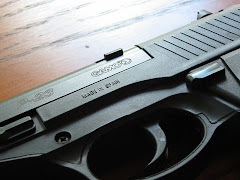
This is a follow up to a post started sometime ago regarding Velocity of Gamo Raptors and other Gamo Pellets (plus Copperhead BB's) from the Gamo P-23 Pistol.
As you may know, the Gamo P-23 is a CO2 operated double action pistol. It is capable of firing .177 caliber round lead pellets and .173 cal. BBs semi-automatically. It also fires any .177 caliber pellet loaded individually into the tip-up barrel.
Part 1 of this P-23 Velocity Post, included testing with the Gamo .177 Match Pellet (7.7gr). This wadcutter pellet served as our control pellet displaying velocities as high as 417 fps, with most shots falling between 394 and 409 fps.
For part 2, we begin testing with another popular pellet as our control. The Crosman 7.9 grain, brown box, Premier, a pellet of known performance it serves as this weeks benchmark. As done previously shots were made 3 and 1/2 feet from the muzzle to the Alpha chronys 1st skys-creen/sensor.We observed the following velocities:
Crosman Premier (Domed) .177 cal, Highest Velocity Measured from Gamo P-23 is 424.3
Shot
Lo: 393.0 5 397.2
Hi: 424.3 4 393.0
Av: 407.2 3 410.8
ES: 31.22 2 410.9
SD: 12.24 1 424.3
Note: Cardboard Box - Premiers used, 7.9 gr.
Gamo Round Ball .177 cal. 8.2gr, Highest Velocity Measured from Gamo P-23 is 400.2 ft/sec.
Shot
Lo: 387.3
Hi: 400.2 4 382.2
Av: 393.4 3 387.3
ES: 12.94 2 397.9
SD: 6.46 1 400.2
Note: Shots were rapid fire from the magazine.
Gamo Hunters (Domed) .177 cal. 7.6gr, Highest Velocity Measured from Gamo P-23 is 448.4 ft/sec.
Shot
Lo: 424.5 5 424.7
Hi: 448.4 4 431.5
Av: 437.9 3 440.0
ES: 23.7 2 445.0
SD: 9.94 1 448.0
Gamo Magnum (Pointed) .177 cal. 7.9gr, Highest Velocity Measured from Gamo P-23 is 437.2 ft/sec.
Shot
Lo: 407.6 6 422.1
Hi: 437.2 5 407.6
Av: 424.4 4 420.9
ES: 29.6 3 422.4
SD: 11.18 2 436.4
1 437.2
Gamo Master Points (Pointed) .177 cal. 7.9gr, Highest Velocity Measured from Gamo P-23 is 433.0 ft/sec.
Shot
Lo: 405.3 5 405.3
Hi: 433.0 4 424.0
Av: 423.9 3 426.0
ES: 27.73 2 431.4
SD: 11.09 1 433.0
At this point I installed new CO2 cylinder lubed with a drop of Crosman Pelgun Oil then discharged a few shots before letting the pistol rest for a few minutes before continuing. Normally I expect at least 40-60 shots per cylinder. This time I put the new cylinder in just to be safe. When I saw the velocity drop in shot 5 above this was done in order to guarantee that reported Raptor Velocity did not drop from a lack of gas.
Gamo Raptor (Specialty) .177 cal. 5.4gr, Highest Velocity Measured from Gamo P-23 is 489.9 ft/sec.
Shot
Lo: 467.5
Hi: 489.9 4 467.5
Av: 475.8 3 489.9
ES: 22.35 2 477.0
SD: 9.94 1 469.0
Note: Light weight domed shaped pellet from non-lead alloy (PBA).
Gamo Rockets (Specialty) .177 cal. 9.6gr, Highest Velocity Measured from Gamo P-23 is 386.0 ft/sec.
Shot
Lo: 368.7 5 368.7
Hi: 386.0 4 384.7
Av: 379.6 3 372.8
ES: 17.34 2 386.0
SD: 8.36 1 385.9
Note: Rockets are a composite pellet with a steel shot pressed into the nose and a lead body.
Crossman Copperhead BBs (Premium) .173 cal. 5.1gr, Highest Velocity Measured from Gamo P-23 is 443.3 . ft/sec.
Shot
Lo: 390.1 5 390.1
Hi: 443.4 4 421.6
Av: 424.5 3 426.1
ES: 53.30 2 441.1
SD: 21.3 1 443.4
Note: Crosman Copper Plated steel bb.
RESULTS OF ALL TESTS:
As we should expect highest velocity was achieved by the Raptor at 489.00 ft/sec. Although it came at the expense of both accuracy and power.
Highest Velocity among the standard weight projectiles was the Gamo Hunter (Domed) at 448.4 ft/sec. The Magnum at 437.2 and the Master Point at 433, came in second and third both of these are 7.9 grain pellets against the Hunters 7.56 grain, so this is not a surprise.
Discussion:
There are two of items that I noticed or would like to discuss. For one , the pistol seems to deliver the first couple of shots at a higher velocity. This happens after a period of resting on it's side for a while (maybe 15-25 min.). And seems to happen for all pellet types.
Second, this kind of pellet velocity out of a barrel measuring less than 4.5 inches is a pleasant surprise. My sense was that this pistol did not shoot that fast out of the box. Unfortunately I didn't have I Chrony to test it then, but I'd swear it shoots harder now. Of course, Gamo had stated a velocity of 410 ft/sec., but I'd always suspected that number was for bbs. I was pleased to see the claim met with pellets as well. Given the velocities produced and the high number of shots produced per cartridge, the valve system seems to be well optimized. Since the pistol is pretty loud and there is often a discharge of vapor from the muzzle I doubt that the pistol could be modified from much higher velocities. Even if the modification were done at the expense of gas per shot/shots per cartridge.
Still it might be fun to try.
Until next time..




